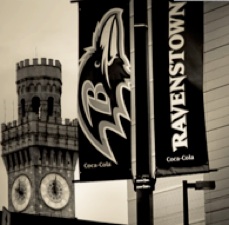Module 3 Topic B:
Physical Culture and the Neoliberal City
Module 3 Topic B:
Physical Culture and the Neoliberal City

1. LECTURE
For six slides per page format (for printing) click : HERE
For one slide per page format (for viewing on computer) click: HERE
2. VIDEO CLIPS
These video clips, unless otherwise advised, will be shown during lecture. They are made available here for revision purposes.
Video Clip 1: A promotional film from “Visit Baltimore” featuring the various attractions of the city’s post-industrial “tourist bubble”.
Video Clip 2: A virtual lap of the Baltimore Grand Prix circuit from 2011.
Video Clip 3: MDbizMedia (2011) discussion of the plans to extend the Baltimore Convention Center.
Video Clip 4: South Baltimore CrossFit as an example of the instrumental leisure of Baltimore’s creative class .
Video Clip 6: WBALTV/NBC Channel 11 (2011) news segment on public response to Baltimore City’s recreation center plan.
Video Clip 7: Trailer for the documentary “The Twelve O’Clock Boys” (2013), which focuses on Baltimores illegal dirt bike subculture.
3. REQUIRED READINGS
It is expected that you will complete these readings prior to the discussion sections, and that–where appropriate–your engage them within your classroom discussion.
Reading III: Hruby, P. (2013, May 29). Sports Welfare Dies Hard. Sportsonearth.
4. THEMATIC REVIEW QUESTIONS
Given the volume of information provided in the classroom, you are strongly advised not to engage the material solely during lectures.
Rather, you are strongly encouraged to review each theme carefully on your own, following which you should test your knowledge and understanding by answering the Thematic Review Questions which can be accessed HERE.
5. KEY CONCEPTS
America as an Urban Nation
Baltimore as an Exemplar of Contemporary Urbanism
Depopulation, Deindustrialization, Tax Bases, and Budget Reductions
From Industrial to Post-Industrial Baltimore
Managerial Welfare as Compared to Entrpreneurial City Governance
The Relationship Between Neoliberalism and the Entrepreneurial City
The Trickle Down Philosophy of Entrepreneurial City Governance
Consumption (as opposed to production) as the Motor of Urban Economic Growth
The Core Spaces of the Re-Invented Post-Industrial City
The Post-Industrial Tourist Bubble
Baltimore’s Post-Industrial Reinvention as Consumption Space
Sport and the Tourist Bubble
The Role of the Maryland Stadium Authority
The Public Subsidization of Baltimore Teams/Stadia
Urban Redevelopment as an Inter-Urban Competition
The Political Necessity and Benefits of Retaining Major League Sport
The Baltimore Grand Prix as Sporting Spectacle
The Financial Impact of Sport Events/Teams/Stadia on City Economies
The Positive and Negative Arguments for Sport Focused Urban Regeneration
The Helicopter Effect
Privileged Spaces and Populations
Three Neoliberal Baltimores
Public and Market Provision of Physical Activity in the Neoliberal City
Physical Culture and the Renaissance City
Urban Regeneration and the Creative Class
The Participatory/Experiential Culture of the Creative Class
The Creative Class and Physical Culture
Redesigning Downtown Spaces of Commercial Play
Physical Culture and the Suburban City
Privilege Amplification
Privatized Sport/Physical Culture Delivery
The “Safe” Suburban Park
Under-Privileged Spaces and Populations
The Fantasy Neoliberal City
The Reduced City Budget Equation
Social Disparities within the Neoliberal City
Disinvestment and Decline in Public Services and Spaces
Baltimore’s Lingering Social Problems
Deprivation Amplification
Disinvestment and Decline in Physical Activity Services and Spaces
The “Risky” Park
The Neoliberalization of the Baltimore Recreation Center
Baltimore’s Dirt Bike Subculture as Recreation and Protest
Three Baltimore Physical Cultures
6. DISCUSSION QUESTION/TASK #10
This question/task will be discussed in discussion sections on:
Monday, December 1
Wednesday, December 3
Rather than wasting public funds on subsidizing the privately owned sport teams or events, city governments should re-direct monies to the core issues which effect the quality of life of those they represent: the citizens. Discuss.
7. ESSAY QUESTION #10 (this is an option for the Module 3 essay)
Critically examine the diverse, position, influence, and experience of sport and physical culture within contemporary Baltimore.
This assignment should be a minimum of 1,500 words (6 double-spaced pages) to answer it comprehensively.
You may find the following academic sources useful in completing this assignment. You do not have to use these sources, they are simply provided for you as an introduction to the literature, and you should use them where appropriate and/or relevant. Also, be warned, these readings do not count towards the THREE additional academic sources you are expected to use within your essays (however, they may direct you toward additional academic sources you could use).
If you choose to complete this essay, and in addition to the sources provided on this page, you need to identify and use (either through paraphrasing or direct quotation) interpretations, insights, or information from a MINIMUM OF THREE appropriate academic sources (in addition to those provided for you on this website).
The deadline for submitting your Module 1II Essay is before class on Sunday December 14. In order to receive feedback from your TA, you can submit a draft version of your essay up to and including Sunday December 10.
Important: The ELMS/Canvas website will not accept essays after the due time and date.
Be sure to review the details on the module essay page. On that page you will find the EVALUATION CRITERIA for module essays (which you are strongly encouraged to read), you will also find links to the appropriate academic sources you should use when researching and writing your module essays, and the style and format guidelines you need to follow when completing module essays. All this information needs to be read, understood, and closely followed for you to succeed in this course.
KNES 287
ONLINE
KNES 287